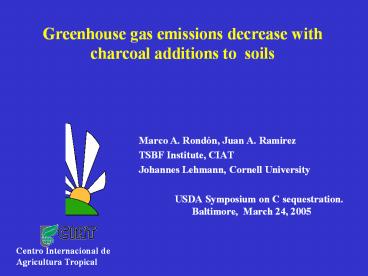Greenhouse gas emissions decrease with charcoal additions to soils PowerPoint PPT Presentation
Title: Greenhouse gas emissions decrease with charcoal additions to soils
1
Greenhouse gas emissions decrease with charcoal
additions to soils
- Marco A. Rondón, Juan A. Ramirez
- TSBF Institute, CIAT
- Johannes Lehmann, Cornell University
- USDA Symposium on C sequestration.
Baltimore, March 24, 2005
Centro Internacional de Agricultura Tropical
2
Charcoal has been part of human history
It can be of natural or anthropogenic origin.
3
Charcoal results from incomplete burning of
biomass
Up to 40 of non combusted biomass remain in
the sites 3 -8 ton/ha of charcoal added to soils
after a burning cycle in the Amazon
4
Rondon et al, 2002
5
Methods for charcoal production were developed
long time ago.
And remain unchanged..
6
Simple methods have also been developed to
improve efficiency and reduce health risk
41 Mton charcoal/y produced worldwide 50 in
Africa, 35 in Latinamerica
7
Charcoal is commonly used in home gardens, raised
vegetable plots and plant nurseries
8
Charcoal additions to soil enhance crop
performance
Lehmann and Rondon, 2004
9
Black carbon adsorbs nitrogen and reduces N
availability
Glaser, 1999
10
Lack of Information on the effects of charcoal on
fluxes of GHG.
- Objective
- Study the effect of charcoal additions to low
fertility soils on net fluxes of CH4 and N2O
from a legume and a tropical grass
11
Experimental details Two plant types Legume
(Glycine max, cultivar. ICA 6) Gramminea
(Brachiaria humidicola, CIAT 679) Soil Typic
haplustox (ph 4.5) very low in nutrients (2 kg
pot-1) Four levels of charcoal 0, 7.5, 15 and
30 g bio-char. kg soil-1 Charcoal from
Calliandra callothirsus . Ground at lt1mm and
mixed with soil prior to sowing Three
replicates in a CRBD
12
Plants grow for 63days in a glasshouse Pots at
50-60 WFPS Root aerial biomass recovered Soil
analysis
13
GHG exchange measured weekly Closed vented
chamber approach
14
Simultaneous analysis of CH4, N2O and CO2 by GC.
FID, ECD detectors
15
Results
16
Charcoal improve soil quality
17
(No Transcript)
18
Black Carbon Effect on BNF
BNF of common beans (Phaseolus vulgaris L.)
determined by isotope dilution (N4)
Rondon et al., in prep.
19
(No Transcript)
20
(No Transcript)
21
(No Transcript)
22
20 year time horizon
23
Similar results have been found for corn and
tropical grasses in savanna oxisols
24
(No Transcript)
25
And in Andisols used for vegetable production in
high fertility trenches on steep hillsides.
26
(No Transcript)
27
CONCLUSIONS
- Effect of charcoal on plant yields can be higher
in legumes due to their BNF ability - Net fluxes of methane and nitrous oxide decrease
with additions of charcoal to soils - Even small amounts of charcoal added to soils can
offset net emissions of CH4 and N2O - The overall GWP of a cropping system can be
controlled by varying the amounts of charcoal
added to soils
28
Opportunities to benefit form charcoal in small
scale agriculture in the tropics
29
Fast growing trees and shrubs will sustain
production of charcoal
30
A bright future for black Carbon
THANK YOU!

